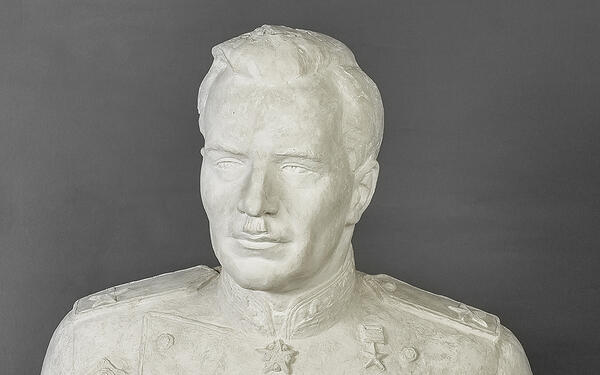The exhibition keeps a bust of the famous military commander, the Soviet Union Marshal, Leonid Govorov.
Govorov was born in a peasant family in 1897. He entered the Polytechnic Institute in Petrograd after leaving Yelabuga Real School in 1916. In December, in the same year, he was drafted into the army and sent to the Konstantinovsky Artillery School, which he finished in 1917. Govorov took part in the First World War and the Civil War battles.
Govorov received the rank of Lieutenant General and was appointed chief of the Western Strategic direction artillery by the beginning of the Great Patriotic War. Govorov participated in the Battle of Moscow, led the troops in action, and in May 1942, according to Georgy Zhukov’s petition, he was appointed commander of the Leningrad Front. He took part in the development of Operation Iskra to break the Leningrad siege and liberate Soviet territories.
In June 1944, General Govorov prepared and conducted the Vyborg offensive operation with the support of the Red Banner Baltic Fleet, Ladoga, and Onega military flotillas. It ended with the Finnish task force ‘Karelian Isthmus’ defeat, and Govorov was awarded the title of the Soviet Union Marshal.
For the successful Baltic operation in January 1945, Leonid Govorov became a Hero of the Soviet Union, and in May he was awarded the highest military commander’s Order ‘Victory’.
After the end of the Great Patriotic War, Govorov became commander of the Leningrad Military District and served in this position until April 1946. Then he was appointed Chief Inspector of the Land Forces, after which he held the position of Chief Inspector of the Armed Forces of the USSR. Later, Govorov became the Soviet Union Deputy Minister of the Armed Forces, served as commander of the Soviet Union Air Defense, and at the same time held the position of the USSR Armed Forces Chief Inspector.
Leonid Govorov was the USSR Deputy Minister of Defense for combat training of the Soviet Army until April 1953. He died on March 19, 1955, and was buried on Red Square near the Kremlin Wall.
Govorov was born in a peasant family in 1897. He entered the Polytechnic Institute in Petrograd after leaving Yelabuga Real School in 1916. In December, in the same year, he was drafted into the army and sent to the Konstantinovsky Artillery School, which he finished in 1917. Govorov took part in the First World War and the Civil War battles.
Govorov received the rank of Lieutenant General and was appointed chief of the Western Strategic direction artillery by the beginning of the Great Patriotic War. Govorov participated in the Battle of Moscow, led the troops in action, and in May 1942, according to Georgy Zhukov’s petition, he was appointed commander of the Leningrad Front. He took part in the development of Operation Iskra to break the Leningrad siege and liberate Soviet territories.
In June 1944, General Govorov prepared and conducted the Vyborg offensive operation with the support of the Red Banner Baltic Fleet, Ladoga, and Onega military flotillas. It ended with the Finnish task force ‘Karelian Isthmus’ defeat, and Govorov was awarded the title of the Soviet Union Marshal.
For the successful Baltic operation in January 1945, Leonid Govorov became a Hero of the Soviet Union, and in May he was awarded the highest military commander’s Order ‘Victory’.
After the end of the Great Patriotic War, Govorov became commander of the Leningrad Military District and served in this position until April 1946. Then he was appointed Chief Inspector of the Land Forces, after which he held the position of Chief Inspector of the Armed Forces of the USSR. Later, Govorov became the Soviet Union Deputy Minister of the Armed Forces, served as commander of the Soviet Union Air Defense, and at the same time held the position of the USSR Armed Forces Chief Inspector.
Leonid Govorov was the USSR Deputy Minister of Defense for combat training of the Soviet Army until April 1953. He died on March 19, 1955, and was buried on Red Square near the Kremlin Wall.



